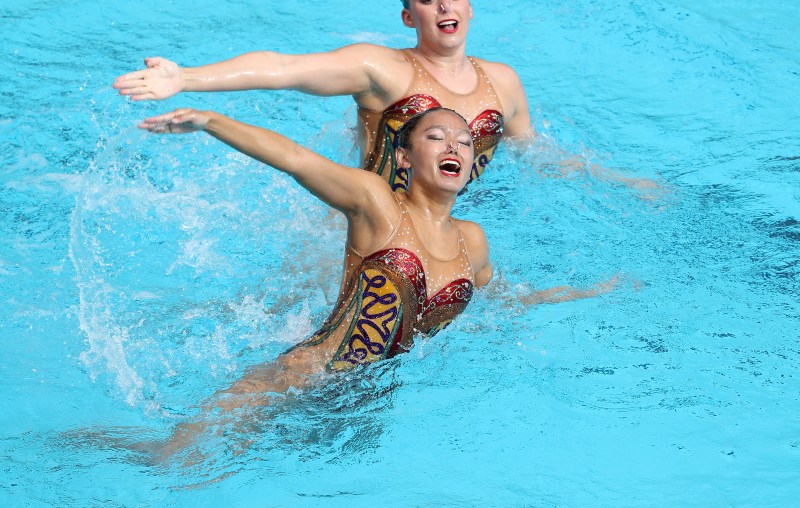“You want that kind of like ability to make people’s heads turn and to make people want to see what’s going on when your music is playing,” head coach Megan Azebu said.
The first step for a synchronized swimming season is picking the music. This process takes place in mid-October.
“We always try to make [the music] both pleasing to us, our team, our athletes and our supporters. We also consider what we think that the officials or the judges are going to enjoy,” Azebu said.
Next, the choreography. This is not a one-sided affair — it is a conversation between athlete and coach. “We like to let the athletes play and we like to let the athletes personality kind of come through,” Azebu said. “Each athlete has their own style, their own strengths and weaknesses. So we like to incorporate a lot of what they can do well into our choreography.”
Every routine represents a balance between the judges and the spectators. “[We try] to put together all of the lifts and things that make synchro appealing to an outside eye as well as making sure the more technical aspects are covered,” Azebu said.
Azebu took over the head coaching job in 2018, but has been a part of Stanford’s team since 2012. With her guidance, Stanford’s synchronized swimming team has been a force to be reckoned with, garnering a top-three finish or higher at the Collegiate National Championships every year since 2013. Stanford’s last championship came in 2016.
Last season, Stanford rode a young team with two seniors to a second-place finish, just 10.0 points behind collegiate champion Ohio State. The team finished second not only overall but also in all four routines — solo, duet, trio and team. After this tantalizingly close finish, the Cardinal are eager for another opportunity to claim a championship.
“A lot of our returning athletes would love to get a taste of coming out on the other side,” Azebu said.
This year’s work has represented a divergence from previous seasons.
“Changing the style of music that we use, changing the way that we swim, or the choreography that we swim in that music, and making sure that it’s enjoyable for the crowd as well as for the judges,” are all discussed when in the process of creating a new routine, she said.
A prime example of this routine-building is junior Jacklyn Luu’s routines. Last year, she swam to a classical Spanish piece. However, this year Luu completely changed gears to a lyrical rock song. While obviously a major genre shift, “she’s really embraced it,” Azebu said. “[The team loves] watching her swim that routine because she really takes on a role and it’s almost like she’s getting into character.”
Stanford has also received a jolt of energy from four new sources. “The freshmen have brought a wealth of energy and enthusiasm and positivity to the pool, and they’re really creative. They really enjoy choreography. They enjoy the performance and the artistic side of synchro, which is something that our team has definitely struggled with, or we’ve been weaker at in the past,” Azebu said.
These four freshman swimmers, Audrey Nguyen, Ava Jih-Schiff, Emily Brieant and Hailee Heinrich, round out the roster with the nine returning members of the team to bring the total up to 13, two more than last year’s 11.
Due to the smaller team sizes in the sport and four routine types, each swimmer can partake in up to three routines.
At the team’s first meet of the year, Luu participated in the duet, solo and team competitions, while Brieant appeared in the duet, trio and team routines. Stanford defeated Wheaton 102-71 at Avery Aquatic Center. The duet of junior Caitlin Klauer and sophomore Grace Alwan scored 77.2333 points, the most out of all Cardinal tandems. Klauer, Alwan and Heinrich paced Stanford in the trio competition with a score of 72.3333. Luu finished first in both solo and Figures A with a 77.9000 and 81.6923, respectively.
Despite the score, this meet wasn’t a showing of Stanford’s true abilities.
“At our first competition, it’s not uncommon for us to swim a just portion of our routines, which is what we did this past weekend,” Azebu said. “When we compete at collegiate nationals in March, we will be swimming about double the length of the sections that we swim this weekend.”
Stanford will next travel to Wheaton to face off in Massachusetts on Feb. 1 and 2. After a competition in Florida against the Gators the following weekend, the Cardinal will return to Avery Aquatic Center against Incarnate Word on Feb. 22 and 23.
Azebu and the synchronized swimming team are still in the process of creating their routines. This process, and the team as a whole, is changing. When asked about the team’s mindset, Azebu said, “I think last year’s group was strong, but I think this year’s group is strong and in different ways. It’s fun to coach kind of different personalities each year.”
This will come into play in March at Regionals and the Collegiate National Championship. After three straight second place finishes, Azebu and the team have a single focus: “going after that national championship.”
Contact Jeremy Rubin at jjmrubin ‘at’ stanford.edu
